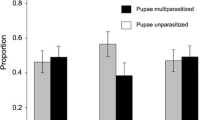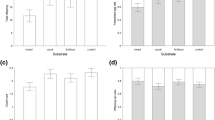Abstract
In experimental populations of the cowpea bean weevil Callosobruchus maculatus (Coleoptera: Bruchidae) and a parasitic wasp Heterospilus prosopidis (Hymenoptera: Braconidae), large changes in the abundances and the fluctuations of both species occurred after approximately 20 generations. In this paper, we examine the hypothesis that this observed change in the dynamics may have been caused by an evolutionary shift in the mode of competition among the bean weevils. A Nicholson-Bailey type model is developed using parameters measured from the experiments. The host larvae can differ in the type of competitive behaviour that they exhibit, which can be either of a contest type or of a scramble type. If a bean contains one or more larvae of the contest type, only one of these will survive and any scramble-type larvae in the bean will be killed. If no contest-type larvae are present within a bean, multiple individuals of the scramble type can emerge from a single bea n. The model assumes many genotypes, differing in the fraction of offspring of the two types. If a high per capita resource availability is maintained, then the scramble type is selected for, but if resources are limited, then the contest type is selected for. The host population at the start of the experiment, taken from a stock culture, was composed mostly of the scramble type. The model is successful in explaining the initial quick increase in the host's abundance, followed by the evolutionary increase in the fraction of the contest type among hosts, resulting in the more stable population dynamics of the host–parasitoid system, as observed in the experiments. However, it predicts a parasitoid abundance much higher than that observed. We discuss alternative hypotheses to explain the observed evolutionary shift in the population dynamics. We also examine the effect of the difference in size of the beans in the stock culture and those used in the experiments.
Similar content being viewed by others
References
Iwasa, Y., Pomiankowski, A. and Nee, S. (1991) The evolution of costly mate preferences. II. The 'handicap' principle. Evolution 45, 1431–1442.
May, R.M., Hassell, M.P., Anderson, R.M. and Tonkyn, D.W. (1981) Density dependence in host-parasitoid models. J. Anim. Ecol. 50, 855–865.
Maynard Smith, J. (1982) Evolution and the Theory of Games. Cambridge University Press, Cambridge.
Nicholson, A.J. (1957) The self-adjustment of populations to change. Cold Spring Harbor Symp. Quant. Biol. 22, 153–173.
Pimentel, D. and Stone, F.A. (1968) Evolution and population ecology of parasite-host systems. Can. Ent. 100, 655–662.
Pimentel, D., Nagel, W.P. and Madden, J.L. (1963) Space-time structure of the environment and the survival of parasite-host systems. Am. Nat. 97, 141–167.
Roughgarden, J. (1979) Theory of Population Genetics and Evolutionary Ecology: An Introduction. Macmillan, New York.
Sait, S.M., Begon, M. and Thompson, D.J. (1994) Long-term population dynamics of the Indian meal moth Plodia interpunctella and its granulosis virus. J. Anim. Ecol. 63, 861–870.
Smith, R.H. and Lessells, C.M. (1985) Oviposition, ovicide and larval competition in granivorous insects. In Behavioural Ecology: Ecological Consequences of Adaptive Behaviour (R.M. Sibly and R.H. Smith, eds), pp. 423–484. Blackwell, Oxford.
Smith, R.H. and Mead, R. (1974) Age structure and stability in models of prey-predator systems. Theor. Popul. Biol. 6, 308–322.
Stokes, T.K., Gurney, W.S.C., Nisbet, R.M. and Blythe, S.P. (1988) Parameter evolution in a laboratory insect population. Theor. Popul. Biol. 34, 248–265.
Toquenaga, Y. (1993) Contest and scramble competitions in Callosobruchus maculatus (Coleoptera: Bruch-idae). II. Larval competition and interference mechanisms. Res. Popul. Ecol. 35, 57–68.
Toquenaga, Y. and Fujii, K. (1991) Contest and scramble competitions in Callosobruchus maculatus (Cole-optera: Bruchidae). I. Larval competition curves and resource sharing patterns. Res. Popul. Ecol. 33, 199–211.
Toquenaga, Y., Ichinose, M., Hoshino, T. and Fujii, K. (1994) Contest and scramble competitions in an artificial world: Genetic analysis with GA. In Artificial Life III (C.G. Langton, ed.), pp. 177–199. Addison-Wesley, Reading, MA.
Tuda, M. (1995) Spatio-temporal population structures and host-parasitoid system dynamics. PhD thesis, University of Tokyo.
Tuda, M. (1996) Temporal/spatial structure and the dynamical property of laboratory host-parasitoid sys-tems. Res. Popul. Ecol. 38, 133–140.
Tuda, M. (in press) Evolutionary character changes and population responses in an insect host-parasitoid experimental system. Res. Popul. Ecol.
Umeya, K., Kato, T. and Kocha, T. (1975) Studies on the comparative ecology of bean weevils. VI. Intra-specific larval competition in Callosobruchus analis (F.). Jap. J. Appl. Ent. Zool. 19, 47–53.
Utida, S. (1957) Cyclic fluctuations of population density intrinsic to the host-parasite system. Ecology 38, 442–449.
Utida, S. (1975) Animal Population Ecology (in Japanese). Kyoritsu, Tokyo.
Author information
Authors and Affiliations
Rights and permissions
About this article
Cite this article
Tuda, M., Iwasa, Y. Evolution of contest competition and its effect on host–parasitoid dynamics. Evolutionary Ecology 12, 855–870 (1998). https://doi.org/10.1023/A:1006550817371
Issue Date:
DOI: https://doi.org/10.1023/A:1006550817371




